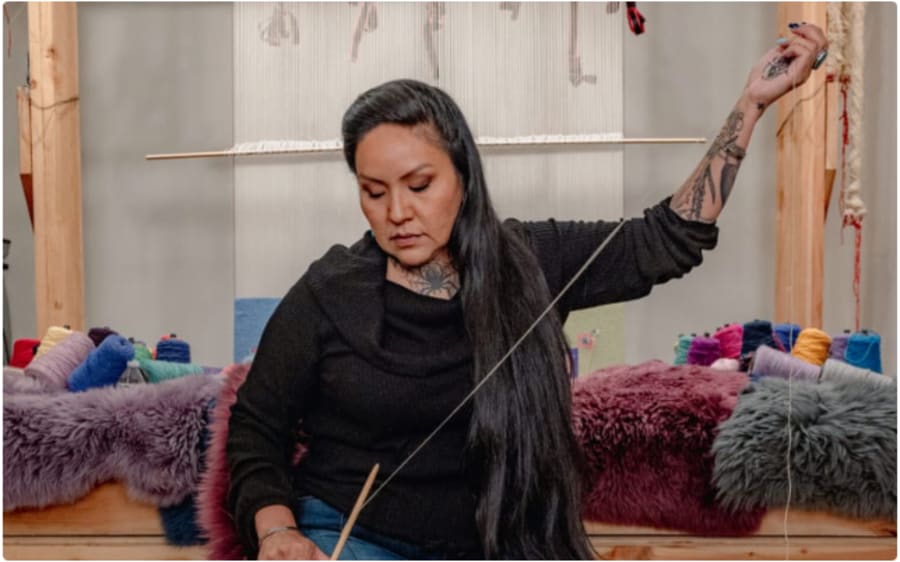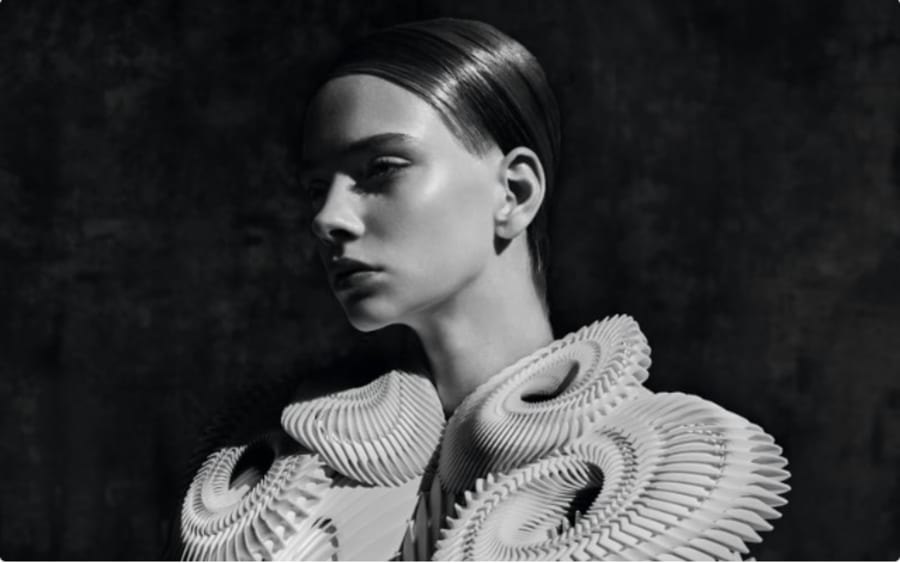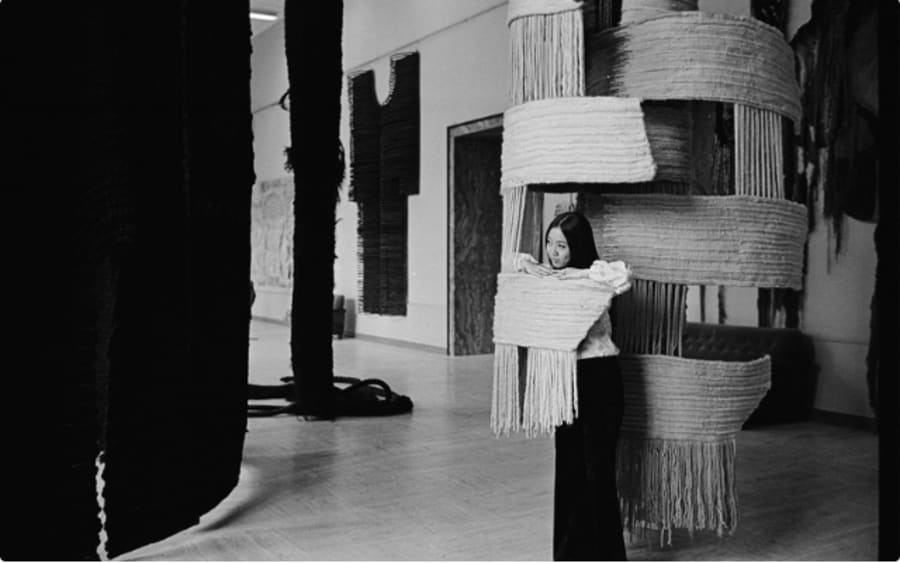When Lexy Ho-Tai began the Fashion Design BFA program at Parsons School of Design in 2012, the world was her oyster. ‘My dream was to live in New York and to revolutionize the fashion industry,’ says Ho-Tai, now a New Orleans-based visual artist and educator. ‘I had visions of using clothing to celebrate people’s individuality and self-expression.’ She quickly realized that her goal may not be possible – at least not on the path she initially projected.
Ho-Tai was disheartened by a lack of critical thinking within the fashion industry. She resented ‘perpetuating toxic beauty standards’ by ‘drawing skinny, tall models.’ While she acknowledges Parsons has evolved over the last decade (and is grateful for the professors who were receptive to her unconventional predilections), Ho-Tai believes her final thesis was ‘the culmination of growing anti-fashion feelings.’
The collection consisted of five ‘Kookers,’ or ‘art monsters,’ made of found and recycled materials, including newspaper, hangers, and beads. After becoming a Museum of Arts and Design’s Van Lier Fellow at the end of 2017, the artist spent 4 months developing this series. With support from the other artists-in-residence, Ho-Tai began ‘letting go of “fashion” as a framework for [her] practice and leaning more into fine art as a lens.’
Often activated through live performances, Ho-Tai’s kaleidoscopic, cacophonic, head-to-toe ensembles draw clear parallels to Nick Cave’s iconic ‘Soundsuits’. Cave, who spearheads the Fashion, Body, and Garment MFA program at the School of the Art Institute of Chicago (SAIC), has continuously fused his passions. As a fiber arts student at Kansas City Art Institute, ‘making garments and presenting them on my friends as a performance via parade was a favorite way of working,’ says Cave, who simultaneously studied dance under the legendary Alvin Ailey. After earning his MFA from Michigan’s Cranbrook Academy of Art in the late 1980s, he opened a store to sell his clothing designs, while also making artworks. It was during this time that he produced his first ‘Soundsuit’. Responding to the 1991 beating of Rodney King by Los Angeles police officers, the wearable artwork was conceived as a protective shield that masks one’s race, gender, and class.
Like Cave, Dutch photographer Viviane Sassen is an undisputed leader in her medium, and she, too, has had extensive fashion training. After spending 2 years studying fashion design at ArtEZ University of the Arts in Arnhem (whose alumni include fashion designer Iris van Herpen), Sassen found herself drawn more towards the images than the garments. While working as a model, she realized photography was her calling.
‘During the mid-90s, the only way to show my pictures was in the pages of magazines,’ recalls Sassen, who became a go-to photographer for independent publications, such as Dazed & Confused, The Face, and i-D, which were rocking the industry with their grittier, experimental imagery. Today, Sassen owes her ‘creative and financial freedom’ to straddling the worlds of fashion and fine art photography.
Sassen also played a crucial role in helping fellow-Dutch artist Anne von Freyburg refine her own practice. Known for her psychedelic, fringed ‘textile paintings’ that reinterpret Rococo masters, von Freyburg studied fashion design, like Sassen, at ArtEZ. In the mid-2000s, during an experimental design workshop with the photographer, von Freyburg had a realization: ‘I am an artist working with cloth as my medium, and I am not a designer.’ She continues, ‘For me, working on the body was too limiting. There was too much emphasis on the dress and not enough on the content or concept of the collection.’
As a fashion design student at Universidade Técnica in Lisbon, and later, on Central Saint Martins’s Fashion Print program, Angolan artist Sandra Poulson had a similar experience. ‘I felt that the fashion crowd was less interested in research and context than I was, and more interested in the aesthetic outcome,’ says Poulson, whose artwork examines Angola’s political, cultural, and socioeconomic landscape.
Poulson found London’s Royal College of Art, where she obtained a fashion MA in 2023, a better fit. ‘The program is attempting to rethink what fashion is as a discipline,’ she says. Catapulting her career, her graduation project, Sabão Azul e Água, was selected for the British Pavilion at the Venice Biennale of Architecture that same year. Composed of fabric stuffed with textile landfill waste and rendered with sabão azul, a blue soap common in Angola, the large-scale installation comments on colonialism, cleansing rituals, labor, and heritage preservation.
Meticulous pattern cutting remains a vital part of Poulson’s artmaking. At Art Basel’s Swiss edition this June, Luanda-based gallery Jahmek Contemporary Art will present ‘Safe to Visit’, a series of new works by Poulson which grapples with Angola’s long history of violence. The series includes an AK-47-shaped sculpture, composed of 28 patterned pieces, hand sewn, and built to scale.
Sara Berman, a British painter who originally studied at Central Saint Martins and ran an eponymous fashion label between 1998 and 2012, harnesses the metaphorical power of clothing in her effortlessly chic portraits. ‘The semiotics of dress are intrinsic to my artistic practice in the exploration of identity,’ she says. Over her 15-year career in fashion, Berman grew ‘bored and dissatisfied’ with the industry’s changing landscape and set up a small painting space in her studio. In her art, Berman marries style and substance with historical references embedded in the subject’s clothing. Argyle knit, for example, both ‘nods to the harlequin trope’ and the idea of ‘knitting as a traditionally female craft,’ while neck ruffs represent ‘a non-gendered status symbol acquired through discomfort and restriction.’
Disenchanted by the ‘manic’ and ‘all-consuming’ seasonal pace of the fashion industry, Florence Reekie, too, found painting a more fulfilling practice. ‘As a student [at Istituto Marangoni in Paris] I was always more taken with the illustration and tailoring side of fashion,’ says the Scottish artist. Reekie developed an aptitude for photorealistic depictions of gloves, ribbons, and voluminous taffeta robes while assisting an artist in London between 2017 and 2022. Calling fabric her ‘nexus’ between fashion and art, she has increasingly challenged herself by painting on silk, velvet, and cotton backdrops.
While the aforementioned artists encompass the worlds of art and fashion, Luke Edward Hall tackles the field of interior design. ‘When I left Central Saint Martins, I knew that I didn’t want to work in fashion as such,’ says the British artist, designer, and illustrator of his menswear education. In his spare time, Hall also sold antiques, which led him to work for architectural and interior designer, and fellow color enthusiast, Ben Pentreath. Since establishing his studio in 2015, Hall and his whimsical illustrations have landed collaborations with top heritage brands in fashion – Burberry and Gant – and design – Ginori 1735 and Rubelli – as well as representation with Athens gallery The Breeder. ‘My point of view is the same, whether I’m making a painting or a piece of knitwear.’
The proliferation of brand collaborations presents an interesting paradox for artists trained in fashion. ‘Is it easier to understand an artist who does a special project with a brand occasionally, than someone who works in both fields?’ Sassen questions. ‘What I do know is that the fashion world loves to work with artists; it gives brands an aura of exclusivity and high-end culture.’
At the same time, Sassen is indebted to her fashion background for teaching her ‘the importance of collaboration.’ For Berman, fashion gave her ‘invaluable business skills’ and a ‘fairly thick skin,’ both helpful in her early days as an artist.
Poulson attributes her work ethic to the intensity of fashion school, which also allowed her ‘to build a foundation of problem solving.’ The Angolan artist hopes fashion schools will make more room for those pursuing less conventional paths. ‘It’s become more and more clear that people who study architecture end up being curators, writers, and other professions beyond building buildings,’ she says. ‘I think that’s also true for fashion, but it isn’t really declared in academia.’
Perhaps, one solution lies in interdisciplinary practitioners, like Cave, who expand and diversify fashion education. ‘I encourage my students to work very openly in any way that suits their ideas. While all students keep “the body” at the center of their work, what they actually make and show can be anything from a 3D-printed installation to a film, performance, or cutting-edge fashion collection,’ says the artist.
As each of these artists has demonstrated, it often takes finding out what crushes your creative soul to determine what feeds it. With experience, that journey may even come full circle. ‘I have had a love/hate relationship towards fashion for a long time, but I’m excited to return to the medium,’ says Ho-Tai, who recently began making her own clothing again and hopes to facilitate sewing and mending workshops. ‘I am interested in art in the everyday – beyond gallery walls and institutions – and I am being reminded that fashion is a beautiful outlet for that.’
Stephanie Sporn is a New York-based author, specialized in the intersection between art and fashion.
Caption for top image: Viviane Sassen, Alek and Grace for Dazed, 2017. Courtesy of the artist.
Published on June 5, 2024.


